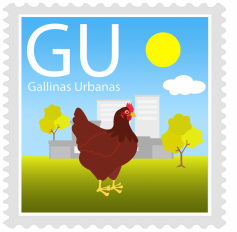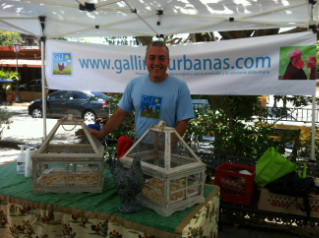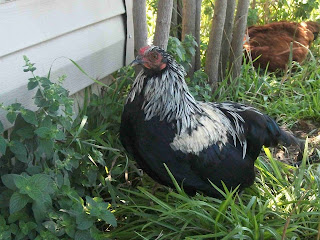I've been tinkering with rumpless blue egg layers for the past few year. The first few years were spent working towards fibromelanistic, rumpless, blue egg layers. Finally, last fall year I was able to tease apart my flock into those with muffs and those that are clean faced. I began doing some hardcore cyber sleuthing about South American chickens, blue egg layers, and history. I've come to realize we have an unprecedented amount of knowledge and amazing tools at our disposal to actually use that knowledge.
That's a bit of a long-winded introduction to this summary of what I think I know about the birds in my backyard.
Technically speaking, Araucanas are a hybrid of two unique South American chicken "breeds", the Colloncas and the Quetros. Over time Araucanas have become prevalent enough to be a designated and standardized breed. However, the Colloncas and Quetros never reached enough prominence to be formally recognized beyond perceived indigenous colloquialism. There are distinct differences between these two landraces.
There are many websites detailing the history of the Araucana breed, the differences between what North Americans call "Araucanas" compared to everywhere else in the world, and why Ameraucanas aren't Araucanas and Easter Eggers aren't Ameraucanas. (Woe be to Gertrude Stein who wrote, "A rose is a rose is a rose by any other name.")
The fine-tooth comb of poultry politicians seemed fairly pedantic until I began seeing well educated, experienced Araucana breeders saying that a Collonca is simply a tuftless Araucana. That makes about as much sense as saying Holsteins are Texas Long-horns without horns.
When two animals are crossed, their genetic material is picked apart with roulette wheel precision, and then stuck back together with velcro-like accuracy. Breeders don't get to pick and choose qualities a la carte. Herein lies the true art of
animal husbandry. Over time the breeder can manipulate the frequency of various phenotypes and eventually be able to reliably produce more or less perfect specimens.
This is where genetic conservation becomes critical because genes and specific combinations of genes can and do get lost without stewardship. The original stewards of the early Colloncas were lived in remote Andean mountain villages. They required animals that could evade jaguars, monkeys, and condors while thriving on minimal supplemental feed. Special birds may have been kept for purposes other than food supply but they would have been tightly coveted.
It has been a mere handful of years that the indigenous tribes of these areas have even been recognized by their governments. Maintaining pure lineages of their chicken flocks has been a very trivial concern as these people tried to just stay alive.
Additionally, in situ preservation is going to be a tremendous challenge thanks to genetic contributions from the industrialized world. High production birds with their genetic homogeneity have found every nook and cranny of the chicken keeping world.
At this point there are two ideological camps among preservationists. The first emphasizes temperament and behaviors and the second emphasizes stabilizing the phenotype of the birds. It is much easier to create a standard for phenotype than behavior.
I would like to think that my approach will ultimately be a complete failure because these birds are so special that they transcend my pale North American capabilities. Perhaps that's true. More than likely I'll eventually have something that merely approximates the work of South American preservationists.
Every time I sit down at my computer and surf the web I find new initiatives, new information, and new knowledge working it's way to the surface. I'm comfortable tinkering with my flock as I know more and as stronger genetic contributions become
available. In the meanwhile, I whole heartedly encourage people to start thinking about their chickens in a broader social context. It will make every egg you collect a bit richer, every feather a bit brighter, and every cluck and crow a deeper in meaning.
Some References You May Enjoy
http://www.aviculture-europe.nl/nummers/09E06A13.pdf
http://gallinachilena.cl
http://www.cetsur.cl/?p=737
http://phys.org/news/2013-08-unscrambling-genetics-chicken-blue-egg.html
































.jpg)










.jpg)

.jpg)

